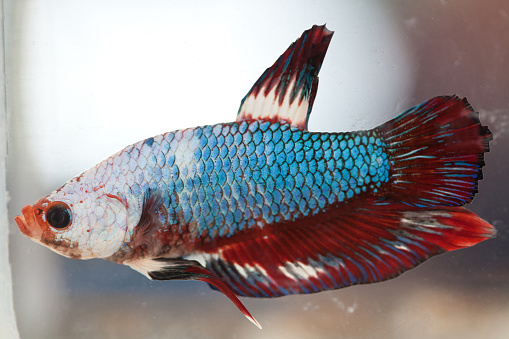Betta Fish Diseases
Betta fish diseases can be very dangerous and can lead to devastating consequences for your fish. Here’s a quick list of some common betta fish diseases, their symptoms, and treatments. You can also take preventative measures by keeping your fish in a quarantine tank until the disease has been properly treated.
Symptoms
Bettas can have a variety of different diseases. It can be difficult to distinguish between these diseases because the symptoms are similar. The best way to identify which type of disease your betta is suffering from is to read up on the symptoms. Having the correct knowledge is a crucial step toward keeping your fish in great health.
You may notice that your betta is not eating. This is a warning sign of a betta disease. The fish may not exhibit an “excited” reaction to food, or may even spit it out. It may also be eating pellets that are too large. Another warning sign is if your betta starts scratching itself.
Ich is a parasitic disease that affects the skin of bettas. A parasite called Ichtyophthirius multifiliis burrows into the betta’s body and feeds on its flesh. Bettas that suffer from Ich will have white spots on their bodies and be lethargic and less active.
If you suspect that your betta has an internal parasite such as ich, you should quarantine it. This can be done by using a clean Betta fish net, and moving it to a smaller tank that has a filtration system. This will allow you to treat the water and eliminate the parasites.
If you have suspected an infection, you must act quickly. Treating your fish early with antibiotics is important. An untreated infection could be fatal for your betta. The infection can cause your fish to become stressed, and it may even lead to respiratory failure if it’s left untreated.
Aside from bacterial infections, other illnesses can affect your betta’s swim bladder. This organ lies behind all other organs, so problems in any of them can also affect the swim bladder. Some signs of swim bladder disease include trouble swimming. Your betta may float in the water, stay atop the tank, or swim lopsidedly.
Another common disease in aquarium fish is velvet infection. This can occur in a variety of different ways, and is caused by a parasite. It manifests as gold dust-like markings on the betta’s body. Treatment depends on the symptoms of the disease. For instance, you may notice your betta’s fins are clumped or disintegrating. Fortunately, you can treat these illnesses with antibiotics.
The best way to avoid these diseases is to make sure your bettas have the best living conditions possible. Make sure the water is changed regularly and that you have a clean tank. Always make sure to change the water in your tank at least every three days. If you suspect that your betta has a disease, do not wait to diagnose your fish. The sooner you treat it, the better your chances of success.
Another common disease that can affect your betta is velvet disease. This is a fungal infection that affects the betta’s slime coat. Symptoms of this disease include a betta losing color and a yellowish coating. The infection can also be difficult to cure. Infected bettas may also lose their fins and body tissues. To avoid a velvet infection, test the water regularly and supplement the tank with copper sulfate.
Treatments
Betta fish diseases are a common problem among bettas, and there are a number of treatments available for them. If your fish is suffering from a disease, you may want to treat it right away by making frequent water changes and disinfecting the aquarium. This will kill bacteria and viruses and prevent them from infecting your fish.
An intestinal parasite can cause your betta to experience changes in behavior and weight loss. It can also be contagious between Bettas. To treat it, use aquarium salt or buy antibiotics at a specialized aquarium store. Another common disease affecting bettas is known as “popeye.” This disease is caused by poor water quality and will affect one or both eyes. The eyes of the affected betta will swell up and appear cloudy.
In some cases, bettas may also suffer from velvet disease. This disease is caused by the protozoan Piscinoodinium pillulare, and infected fish will have a yellow or brown hue. The fish will also be lethargic and stop eating. However, treatment for this disease is relatively easy.
Another disease that affects bettas is “popeye disease.” This is an infection that affects their eyes and may be caused by overfeeding or feeding it the wrong type of food. The wrong type of food can swell up in the fish’s stomach and prevent it from absorbing nutrients properly. This can cause your betta to lose interest in eating and may even cause them to lose appetite. A treatment for constipation might include feeding your betta a small amount of water fleas or daphnia to aid in digestion. However, do not feed your betta copper as this can be harmful to your betta’s health.
If you suspect your fish of suffering from any of these diseases, you should consult your veterinarian. Many of these diseases can be treated with antibiotics. However, you should also take care to make sure your betta is properly quarantined, as bacteria in the water can make the fish infected.
Another common disease that affects bettas is “popeye disease”. This disease is easily recognized by its bulging eyes. Fortunately, there is a treatment for popeye, but it’s important to monitor your betta regularly and treat it as soon as possible. It may take a few weeks or even a month to heal.
A licensed veterinarian is the best person to diagnose and treat your betta fish. However, many of these diseases are easily identifiable by an experienced betta owner. This information is for educational purposes only, and should not be construed as medical advice. In addition, you should never use this information to diagnose your own fish.
Ammonia is another common cause of betta fish deaths, so it’s important to treat your betta’s water regularly to prevent it from becoming toxic. Ammonia is present in municipal water supplies and can reach high concentrations in your betta’s tank. It will cause your fish to display symptoms like lethargy and listlessness, and its gills will become red and inflamed.
Prevention
Preventing betta fish diseases starts with providing a healthy environment for your fish. Certain diseases affect bettas differently, so ensuring that you change the water regularly is crucial. Some diseases are more serious than others, and there are medicines to help combat them. If you suspect that your fish is suffering from a disease, it is best to get it treated as soon as possible.
Fungus and bacteria can cause a variety of betta fish diseases. The most common of these is rotting fins, which can affect your fish’s fins. While mild cases are treatable, more serious cases require antibiotic treatment. Fungi can spread to other fish in the tank, making early diagnosis and treatment essential.
Aside from bacterial infections, you should also look for signs of a variety of parasites. Internal parasites can cause your betta to lose weight and can be difficult to detect. Treatments for internal parasites include daily 100% water changes and anti-parasite pellets. An infection can also cause your betta to have a swollen eye, known as exophtalmia. This infection can be contagious and cause loss of an eye. Another infection to watch out for is betta tuberculosis. It can affect all of the fish in the tank. This disease is caused by parasites that spend their entire life cycle in the water.
Some bacterial infections can cause your betta to have a hard time eating. Treatment for these conditions may include water changes, antibiotics, or Bettafix, which is a fish health product. These medications can be purchased online or from a specialty fish store. If you suspect your fish of being infected, it is best to consult a professional.
If you think your betta may have a disease, it’s important to treat it as soon as possible. Symptoms of betta fish diseases include red patches on the fins and tail, and cotton-like bumps on the gills or skin. If you notice these signs, you should change the water immediately and check the water parameters. In addition, you should add salt to the water to reduce the stress on your fish.
Among the most common diseases affecting bettas is septicemia. This bacterial infection affects the gills and makes the fish unable to breathe. Septicemia can be caused by introducing new community fish or by feeding your betta infected food. Red streaks on the fins can indicate septicemia. It’s important to monitor your fish closely to detect this disease because it can spread to other bettas in the tank.
A good betta care regimen can prevent most betta fish diseases. Proper water quality and regular sanitation is the key to maintaining the health of your betta. The right environment helps your betta fight off illnesses and maintain a beautiful aquarium.



